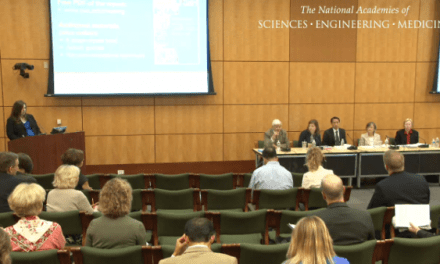SPECIAL SECTION: OTC HEARING AIDS
A look at the determining factors for consumer success with OTC hearing aids
By Elizabeth Convery, PhD
What personal and technological factors will influence consumers’ success with self-fitting OTC hearing devices? Recent studies suggest that manufacturers and providers must address a range of important personal and device factors before OTC and self-fitting can become a viable option for adults with hearing loss.
Access to hearing healthcare is one of the key issues our profession faces today.1 To expand and diversify the options available to adults with hearing difficulties, the Over-the-Counter (OTC) Hearing Aid Act was passed in 2017.2 One of the assumptions underlying the emergence of OTC and other direct-to-consumer (DTC) channels is that hearing healthcare accessibility will improve simply as a result of increasing availability, without considering factors that could influence the success of these new service delivery models.
This article explores the personal and technological factors that influence success with self-fitting devices, and suggests ways in which manufacturers and providers could address these factors when offering OTC devices.
Which Consumers Are Most Likely to Find Success with OTC Hearing Aids?
Research conducted at the National Acoustic Laboratories (NAL) over the past decade has identified several personal factors that make it more or less likely that an individual will be able to fit themselves with a self-fitting hearing aid. In a recent trial, 60 older adults—half with previous experience with conventional hearing aids and half without—fitted themselves with a pair of SoundWorld Solutions Companions, which are fully featured, commercially available self-fitting hearing aids. One aim of the study was to determine whether there were any personal characteristics that influenced participants’ success with the self-fitting task.3
We found that the two primary predictors of self-fitting success were:
- Previous experience with conventional hearing aids, and
- Previous experience with smartphones.
That each of these factors play such an important role in the outcome is a sensible finding, given that the Companion looks and operates similarly to a conventional hearing aid and the self-fitting process is largely app-driven.
However, these findings can also be interpreted to mean that users who lack this experience—that is, people who are new to amplification—are at a disadvantage when it comes to self-fitting. This is problematic given that it is likely to be new, rather than experienced, hearing aid users pursuing devices through the OTC channel.
The recent MarkeTrak 10 survey4 asked its respondents about their views on OTC hearing aids and the likelihood of purchasing through this channel. Specifically, they asked existing hearing aid users “How do you think you would have purchased if an OTC option had been available?” and they asked non-users with hearing difficulties “How do you think you will purchase, if an OTC option is available?” While the majority (88%) of existing users responded that they would “probably” or “definitely” purchase their next pair of hearing aids through a hearing healthcare professional, only 56% of non-users responded in this way. This suggests that the primary target market of OTC will be current non-users who, for whatever reasons, have chosen not to pursue hearing healthcare through the traditional face-to-face channel.
The three other factors that influenced self-fitting success in our study of the SoundWorld Solutions Companion were:
- Cognitive function;
- Self-efficacy for hearing aid use (the belief in one’s own ability to adapt to and manage hearing aids), and
- Health locus of control (the extent to which individuals believe they can influence events that occur in their lives).
Participants who had better cognitive function, higher self-efficacy for using and adapting to hearing aids, and a more internally oriented locus of control (a stronger belief in one’s own ability to influence life events) were significantly more likely to self-fit successfully. None of these factors is routinely assessed in traditional face-to-face hearing healthcare. While the influence of these factors on success with traditional hearing rehabilitation is beyond the scope of this article, people with hearing difficulties and poor cognitive function, lower self-efficacy for hearing aid use, or a more externally oriented locus of control (a belief that life events are influenced by chance, luck, or other people, as opposed to one’s self) may be unsuccessful with OTC hearing aids.
Therefore, providers of OTC devices should consider ways in which they could assess these and other factors among their prospective customers in order to tailor their device recommendations individually. For example, a short questionnaire on the landing page of a website could ask questions designed to tap into these constructs, and several device options could be displayed to the prospective customer as a result, telling the customer that based on their input, these are the devices with which they are most likely to get the best outcomes.
What Device Features Are Required for Success with OTC Hearing Aids?
Once an OTC device has been purchased, characteristics of the device itself become more important as the device is used in everyday life. The second aim of our evaluation of the SoundWorld Solutions Companion self-fitting hearing aid was to evaluate users’ experiences and outcomes over a 12-week trial period.
In the subgroup of participants with previous experience with hearing aids, we compared outcomes between their own hearing aids and the self-fitting hearing aids.5 While speech-in-noise performance was equivalent, there were significant differences in both self-reported benefit and satisfaction. As measured by the Abbreviated Profile of Hearing Aid Benefit (APHAB),6 participants reported significantly greater benefit from their own hearing aids in acoustic environments where sound levels were uncomfortable or aversive. Similarly, as measured by the Satisfaction with Amplification in Daily Life (SADL) scale,7 participants were significantly more satisfied with their own hearing aids with respect to their physical appearance and the effect they believed the devices had on the way others treated them.
Interestingly, the factors that influenced their perceived benefit and satisfaction were not related to the fact that one device was self-fitting while the other had been fitted by an audiologist. Rather, the discrepancies in benefit and satisfaction reflected the specific characteristics of the self-fitting hearing aid used in the study. While the SoundWorld Solutions Companion enabled users to adjust their settings, it lacked an effective method of dealing with uncomfortably loud sounds, such as an MPO control. The Companion was also physically larger and bulkier than the conventional hearing aids our participants were used to wearing. During semi-structured exit interviews conducted at the end of the trial, participants also noted that while they liked the fact that the Companion’s battery was rechargeable, they also noted that there was no option to immediately replace the battery pack when they lost power; rather, they had to plug the devices in and wait for a couple of hours until they had been recharged. Similarly, there were issues related to the participants’ interpretations of the voice prompts. While they enjoyed that the hearing aid would announce the name of the new program whenever they switched programs, the voice messages that pertained specifically to the Bluetooth connection were prone to misinterpretation; when they heard the message “connection lost,” many assumed that this meant the hearing aid was no longer functional.
Taken as a whole, these findings suggest that manufacturers should focus greater efforts on ensuring usability of their devices and making sure they align with the preferences, needs, expectations, and capabilities of their intended user base. Participatory design technique—in which users play an active and ongoing role in co-designing, co-developing, and co-evaluating new technologies with researchers and developers—could be used to facilitate user involvement and to ensure that the end users of self-fitting and OTC devices are optimally set up for success.8
Conclusion
OTC and self-fitting devices have the potential to be exciting and disruptive forces within hearing healthcare, opening up new avenues for people to address their hearing difficulties. However, availability is not sufficient for true accessibility. Manufacturers and providers must address a range of important personal and device factors before OTC and self-fitting can become a viable option for adults with hearing loss.
Correspondence can be addressed to Dr Convery at: [email protected].
Citation for this article: Convery E. Meeting the challenges of OTC: Who are self-fitting hearing aids really for? Hearing Review. 2020:27(6):14-15.

About the Author: Elizabeth Convery, PhD, is a senior research audiologist at the National Acoustic Laboratories (NAL) in Sydney, Australia. Her current research focuses on self-fitting hearing aids and the development of service delivery models to foster and support self-management skills among hearing-impaired adults. Dr Convery also maintains an active interest in humanitarian audiology, providing voluntary clinical services on outreach trips throughout northern Australia and the South Pacific.
References
1. The National Academies of Science, Engineering, and Medicine (NASEM). Hearing Health Care for Adults: Priorities for Improving Access and Affordability. https://www.nap.edu/catalog/23446/hearing-health-care-for-adults-priorities-for-improving-access-and. Published 2016.
2. Warren E, Grassley C. Over-the-counter hearing aids: The path forward. JAMA Internal Medicine. 2017;177(5):609-610.
3. Convery E, Keidser G, Hickson L, Meyer C. Factors associated with successful setup of a self-fitting hearing aid and the need for personalized support. Ear and Hearing. 2019;40(4):794-804.
4. Powers TA, Rogin CM. MarkeTrak 10: Hearing aids in an era of disruption and DTC/OTC devices. Hearing Review. 2019;26(8):12-20.
5. Keidser G, Convery E. Outcomes with a self-fitting hearing aid. Trends in Hearing. 2018:22.
6. Cox RM, Alexander GC. The abbreviated profile of hearing aid benefit. Ear and Hearing. 1995:176-186.
7. Cox RM, Alexander GC. Measuring satisfaction with amplification in daily life: The SADL scale. Ear and Hearing. 1999;20(4):306- 320.
8. Convery E, Heeris J, Ferguson M, Edwards B. Human-technology interaction considerations in hearing healthcare: an introduction for audiologists. American Journal of Audiology. In Press.
Other Articles in the OTC Hearing Aids Special Section series below:
Understanding Hearing Aid Rejection and Opportunities for OTC Using the COM-B Model
Tech Trends in OTC Hearing Aids
Individualizing Hearing Healthcare: New Opportunities in OTC Hearing Aids






I believe that self fitting OTC will be an advantage because user himself/herself know how it fit for various environment. I have try many difference brand of hearing aids, at the moment, none of its help on noise situation. that’s why i am looking for a self fitting hearing aid in order to set it up myself at the noise environment. Maybe an app may help a lot if it can measure a conversation and provide a bar chart for user which frequency to be tuned.